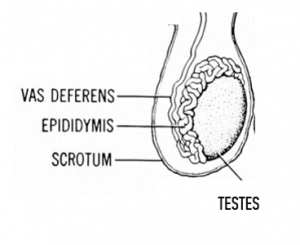Food Animal Male Urogenital Surgery
Teaser animals
Teaser animals are useful to improve herd reproduction (see the ram effect). Having males with testosterone around improves cycling, fertility and heat detection. Teaser animals should be amenable to handling, not so large that they injure the females, and must be interested in their jobs.
In bulls, we typically recommend two procedures.
- Prevent pregnancy
- Teaser animals are not destined to sire offspring
- If offspring are needed, no need to create a teaser animal
- Prevent intromission
- This is to minimize disease transmission
Pregnancy prevention
We have two main options. For both, the goal is removal of a portion of the sperm pathway. Both affect the same path, just different parts.

Vasectomy
-
- Vasectomy can be more challenging. Depending upon the age of the animal, the vas can be very thin, hard to find and can resemble the nerve. Transecting the nerve does not prevent pregnancy. However, vasectomy may be easier than epididymectomy if the procedure is performed laparoscopically (camelids) or in adult sheep (due to the restraint position of cradling them on their hindquarters). A centimeter or longer chunk of the vas deferens should be removed to minimize the risk of recanalization.
Epididymectomy
-
- Epididymectomy is typically easier once the surgeon has performed the first one. The epididymis is hard to miss. The only challenge to the surgery is figuring out where to ligate since there isn’t a discrete structure. However, due to the larger tissue volume being removed, hemorrhage is more likely. If uncontrolled, hemorrhage can lead to healing complications. Most of the tail of the epididymis should be removed. Recanalization is possible but not common.
Prevent intromission
Particularly in open herds (herds with new animals coming in), teaser animals should not actually breed the females as this can increase the risk of venereal disease transmission. In order to prevent this, several options exist with varying success rates and healing times.
Penile translocation – aka Sidewinders
- The preputial opening is moved to the flank of the bull. The penis is left untouched. When the bull gets an erection, the penis is extruded out his flank and he usually misses the target. Since there is no pain involved, most of these bulls maintain their libido.
- This procedure requires general anesthesia. It is typically performed in hospitals rather than in the field.
- Healing time is 2 months (plan ahead).
Preputial pouch
- The preputial opening is sutured closed and another opening created ventrally for urine flow. The penis is left untouched. As long as the urine hole is small enough, the penis cannot be extruded. Since there is no pain involved, most of these bulls maintain their libido.
- This procedure requires general anesthesia; however, it is simpler to perform than the penile translocation.
- Urine collects in the sheath requiring periodic flushing (higher maintenance).
- Healing time is 2 months (plan ahead)
Penectomy
- The penis is shortened to prevent intromission.
- Hemorrhage is a risk with this procedure. Careful closure of the corpus cavernosum is required.
- Bulls do not maintain their libido due to apparent discomfort.
- Healing time is 2 months.
Artificial thrombus model
- Methylmethacrylate (mixture of powder and liquid which cures into a solid form) is injected into the corpus cavernosum to prevent erection due to blockage of blood flow.
- The procedure can be performed in the standing animal and is relatively straight forward
- If the urethra is injected instead of the corpus cavernosum, the resultant urinary obstruction can be fatal.
- Healing time is 2 weeks.
Penis tie-down
- Adhesions are created between the penis and the internal sheath, preventing exteriorization of the penis.
- The procedure is relatively quick and straight forward
- Adhesions may break down if the bull gets an erection prior to strong scar tissue formation
- Healing time is 2 months.
Iatrogenic preputial stenosis
- The internal prepuce is wrapped with a K wire (Kirschner wire) to prevent exteriorization of the penis while still permitting urine flow
- Creating the appropriate diameter to keep the penis in place is a bit of an art
- The procedure is quick and straight forward
- Healing time is 2 weeks
Resources
Surgical techniques for the preparation of teaser bulls, 1995 VCNA – older but one of my favs for images and descriptions
Development of Teaser Bulls Under Field Conditions, 2008 VCNA- useful images and explanations
Occlusion of the corpus cavernosum penis in bulls intended for estrus detection: 18 cases (2002–2016), 2019 JAVMA- latest and greatest on this technique; includes challenges and success rates (pdf download link)

